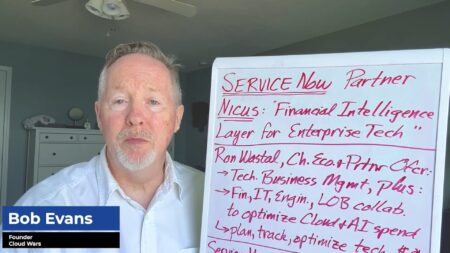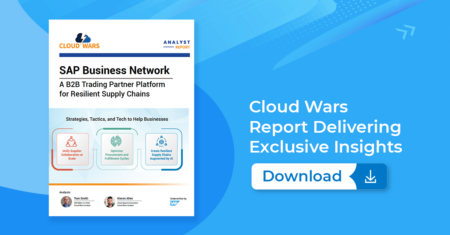While Microsoft’s not one of the leading enterprise-applications vendors, its massive influence as the world’s #1 cloud-computing provider is making it a major player in the quiet but unmistakable revolution in the SaaS business.
I’ve written about this upheaval in a number of places recently, including in this week’s Cloud Wars Newsletter, titled “The SaaS Revolution.” You can read that newsletter issue here (or subscribe here, for free). Additionally:
On the SaaS Revolution
Why Google Cloud and Salesforce Are Pumping $18 Billion into Analytics and BI
Attention Workday, SAP and Oracle: Is Salesforce Jumping into HCM?
Salesforce’s New Strategy: All-In on ‘Customer 360,’ Powered by MuleSoft
Workday’s Path to a $1-Billion Quarter: 10 Key Insights
SAP and Qualtrics’ $1.6-Trillion Opportunity: Exclusive Talk with SAP CEO Bill McDermott
Microsoft Begins Selling SAP Applications As Cloud Ecosystem Evolves
ServiceNow Set to Unveil ‘Killer App’ as Market Cap Surpasses $50 Billion
What’s Microsoft’s Role in the SaaS Revolution?
How does Microsoft fit into this turbulent and rapidly evolving marketplace? I believe Satya Nadella and company have become one of the key drivers of this SaaS revolution in two ways: not only through its own SaaS products and platforms for customer-driven app dev, but also through its innovative and, in my view, industry-leading go-to-market approaches.
So it was timely that Microsoft corporate VP Alysa Taylor, who leads the company’s business apps and industry marketing, recently spoke at an investors conference about what Microsoft’s doing with Dynamics 365 and Power Platform. (You can read the full transcript of her comments here.)
With Dynamics 365, Taylor described a sweeping rewrite of the entire portfolio for Azure, coupled with a common underlying data architecture.
“Yeah, it’s been a very exciting evolution. We had a set of assets that were a collection of ERP assets that were predominantly on-prem. And then, we had a CRM business that we built at Microsoft. And they were actually two very disparate divisions within Microsoft. So we had, effectively, competing ERP systems and then a CRM system,” Taylor said at the Bank of America Merrill Lynch Global Technology Conference.
‘Big, Monolithic, Siloed Applications’ Are Headed for the Tar Pit
Taylor continued:
“Then we looked forward to what does the world look like in 10 years, particularly as customers are going through the adoption of a digital platform, and we felt that having these big, monolithic, siloed applications wasn’t the direction that we needed to take for our customers.
“So we actually took on the effort of bringing those assets together, converging them onto the Azure platform. We went from our on-prem and our hosted on-prem environment, rebuilt them onto Azure, and then we broke them down into purpose-built applications. So, they’re now aligned by marketing, sales, service, finance, operations and talent.”
A couple of key points stand out from Taylor’s comments. First is her insistence that the enterprise apps of yesterday and today will simply not fulfill the needs of businesses in the digital age. Second, she points to the need to move away from siloed apps that cannot align to the shape of modern business. And third, Taylor describes the need for purpose-built applications that customers can “easily adopt as they’re doing through their digital transformations.”
Tying that all together, she said, is Microsoft’s “unified data set, which we call Common Data Service. So we can not only share data freely across those applications but also ingest data from other assets: LinkedIn, or Office, or communication/collaboration history, and also our partner ecosystem.”
Once business customers have that ability to accelerate their digital re-inventions by opening up data that had been trapped in siloed applications, Taylor said, they’re then able to adapt and extend those applications with the Power Platform.
How Microsoft Truly Differentiates Itself
“When we think about our differentiation and where we’ve made strides, it’s in the enabling of that data layer: being able to ingest data across the applications at the data platform level, being able to extend it, customize it, and be able to ingest data from all different sources so you’re not just in a CRM set of data. And then also having this co-build mentality,” Taylor said.
There’s another revolutionary concept that underpins the SaaS Revolution: “be able to ingest data from all different sources so you’re not just in a CRM set of data.”
And from there, the Azure foundation allows easy adoption of AI and ML.

“Our engineering teams across Microsoft 365 and Dynamics and Azure are co-building features that are deeply integrated in a way so you can do things like machine learning within Power BI,” said Taylor.
“You have out-of-the-box artificial intelligence within Dynamics 365, and you have native communication with Office integration.
“That’s very unique to us and we think that’s a big differentiator when we think about business applications because the market, as you guys all know, is highly fragmented.
“And so what customers end up with is a collection of assets—and again, their data is sort of trapped in these different silos,” and can’t be exploited to deliver the types of exceptional experiences customers are demanding in the digital age—an interaction Microsoft calls the “digital feedback loop.”
“It’s this notion that you can take all components of an organization—people, operations, products—and digitally connect them. You have all facets of an organization, and at the center is data, and you’re able to apply intelligence over that and then digitally connect every aspect,” Taylor said.
The Driving Force Behind the SaaS Revolution
That leads to what might well be the primary animating force behind the SaaS Revolution: the ability to help businesses have true 360-degree views of their customers.
“Think about a world where you have a unique view of your customers connected to your products connected to your backend operations creating a 360-degree view that your employees have. That’s what we talk about as the digital feedback loop.”
Primary Example: Retailer H&M
Taylor cited global retailer H&M as a great reference case for putting this new type of application-plus-data approach into practice.
“They have a very large ERP system that governs their entire financials,” Taylor said. “And about a year ago they started a boutique line called Afound, but they needed a rapid supply-chain management system.
“They’ve had to modernize their operations because, to be able to go from mass scale—which H&M is known for—to be able to be in a more boutique, nimble-type scenario, they needed a different supply-chain management company. And so, they started with Dynamics 365.
“They expanded from there into being able to have better insight into their customer—so they adopted Dynamics 365 Customer Service. Then they wanted their employees in-store to be able to have real-time access to the inventory, so they took all of that data and built a unique PowerApp to give employees that view of the backend operations and the customer purchasing history,” Taylor explained.
“And the latest thing they’re doing is we have a set of mixed-reality applications that we brought into the portfolio, and they’re using HoloLens and the Dynamics 365 mixed-reality applications to do a smart mirror in the store.
“So you can actually have a mirror that will recommend for you the best look: if you have a sweater and you want it to be different—bigger, longer, shorter. They’re piloting that in their flagship store on Fifth Avenue.”
Tools for “Citizen Developers” with Power Platform
As businesses like H&M make that type of relentless innovation the norm rather than the exception, those companies will need to create their own unique applications to enable new capabilities.
“Power Platform is a set of technology that spans across all assets of the Microsoft cloud,” Taylor said, “and it was designed very much as a citizen or a self-service platform to let non-technical people be able to analyze, automate and act on your data. Because—in case you haven’t heard—we think data is our customers’ greatest asset.”
As demand for such no-code/low-code tools mushrooms as businesses gain more developer capabilities, these “citizen developers” will also become the norm rather than the exception, Taylor said.
“We’ve seen an incredible groundswell of citizen developers gravitating to that.”
Disclosure: at the time of this writing, Microsoft was a client of Evans Strategic Communications LLC.
Subscribe to the Cloud Wars Newsletter for in-depth analysis of the major cloud vendors from the perspective of business customers. It’s free, it’s exclusive, and it’s great!








